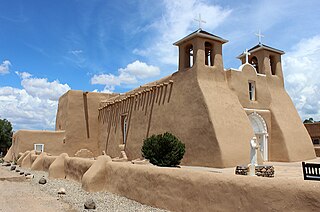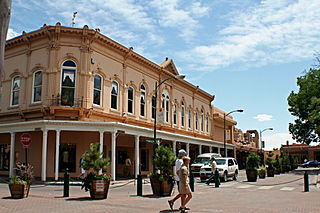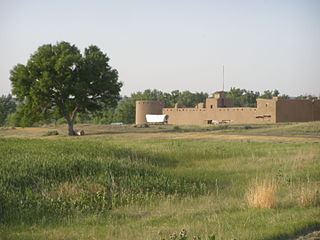
Taos is a town in Taos County in the north-central region of New Mexico in the Sangre de Cristo Mountains. Initially founded in 1615, it was intermittently occupied until its formal establishment in 1795 by Nuevo México Governor Fernando Chacón to act as fortified plaza and trading outpost for the neighboring Native American Taos Pueblo and Hispano communities, including Ranchos de Taos, Cañon, Taos Canyon, Ranchitos, El Prado, and Arroyo Seco. The town was incorporated in 1934. As of the 2010 census, its population was 5,716.

The Taos art colony was an art colony founded in Taos, New Mexico, by artists attracted by the culture of the Taos Pueblo and northern New Mexico. The history of Hispanic craftsmanship in furniture, tin work, and other mediums also played a role in creating a multicultural tradition of art in the area.

Picuris Pueblo is a historic pueblo in Taos County, New Mexico, United States. It is also a census-designated place (CDP) and a federally recognized tribe of Native American Pueblo people. The 2010 census estimated that 68 people lived in the CDP, while 267 people in the U.S. reported being of the tribal group Picuris alone and 439 reported being of the tribal group Picuris alone or in combination with other groups. Picurís Pueblo is a member of the Eight Northern Pueblos. Their own name for their pueblo is P'įwweltha, meaning "mountain warrior place" or "mountain pass place." They speak the Picuris dialect of the Northern Tiwa language, part of the Kiowa-Tanoan language family.

Charles Bent was an American businessman and politician who served as the first civilian United States governor of the New Mexico Territory, newly acquired by the Military Governor, Stephen Watts Kearny, in September 1846.

Bent's Old Fort is an 1833 fort located in Otero County in southeastern Colorado, United States. A company owned by Charles Bent and William Bent and Ceran St. Vrain built the fort to trade with Southern Cheyenne and Arapaho Plains Indians and trappers for buffalo robes. For much of its 16-year history, the fort was the only major white American permanent settlement on the Santa Fe Trail between Missouri and the Mexican settlements. It was destroyed in 1849.

Ceran St. Vrain, born Ceran de Hault de Lassus de Saint-Vrain, was the son of a French aristocrat who immigrated to the French Louisiana in the late 18th century; his mother was from St. Louis, where he was born. To gain the ability to trade, in 1831 he became a naturalized Mexican citizen in what is now the state of New Mexico. He formed a partnership with American traders William, George and Charles Bent; together they established the trading post of Bent's Fort. It was the only privately held fort in the West.

Old Town is the historic original town site of Albuquerque, New Mexico, for the provincial kingdom of Santa Fe de Nuevo México, established in 1706 by New Mexico governor Francisco Cuervo y Valdés. It is listed on the New Mexico State Register of Cultural Properties as the Old Albuquerque Historic District, and is protected by a special historic zoning designation by the city. The present-day district contains about ten blocks of historic adobe buildings surrounding Old Town Plaza. On the plaza's north side stands San Felipe de Neri Church, a Spanish colonial church constructed in 1793.

The Taos Revolt was a populist insurrection in January 1847 by Hispano and Pueblo allies against the United States' occupation of present-day northern New Mexico during the Mexican–American War. In two short campaigns, United States troops and militia crushed the rebellion of the Hispano and Pueblo people. The rebels, seeking better representation, regrouped and fought three more engagements, but after being defeated, they abandoned open warfare. While US troops were overwhelmingly victorious, it did result in the New Mexico Territory forming with proper representation and recognition for Santa Fe de Nuevo México's citizenry in the Treaty of Guadalupe Hidalgo.

Martinez Hacienda, also known as Hacienda de los Martinez, is a Taos County, New Mexico hacienda built during the Spanish colonial era. It is now a living museum listed on the National Register of Historic Places. It is located on the bank of the Rio Pueblo de Taos.

Taos Plaza is a center of shops and monuments within the Taos Downtown Historic District in Taos, New Mexico.

The Santa Fe Plaza is a National Historic Landmark in downtown Santa Fe, New Mexico in the style of traditional Spanish-American colonial cities. The plaza, or city square, was originally, and is still to this day, the center gathering place in town. Many know it as "the heart of Santa Fe". The landmark has since grown into a playground for many tourists interested in Spanish, Native American, and Mexican cultures, and includes music, design, jewelry, art and dance. It is home to annual events including Fiestas de Santa Fe, the Spanish Market, the Santa Fe Bandstand, and the Santa Fe Indian Market.

The Kit Carson House is a historic house museum at 113 Kit Carson Road in central Taos, New Mexico. Built in 1825, it was from 1843 until his death the home of frontiersman Kit Carson (1809-1868). A good example of Spanish Colonial architecture, it is now owned by the local Masonic fraternity, and serves as a museum dedicated to Carson's life. It was designated a National Historic Landmark in 1963.

San Francisco de Asís Mission Church is a historic and architecturally significant building on the main plaza of Ranchos de Taos, New Mexico. Originally the center of a small Mexican and Indian 18th Century agricultural community. Built between 1772 and 1816 replacing an earlier church in that location. New Mexico was then part of the Vice-Royalty of New Spain. It is a fine example of a New Mexico Spanish Colonial Church, and is a popular subject for artists. It was designated a National Historic Landmark in 1970.

Ranchos de Taos Plaza is a historic district in Ranchos de Taos, New Mexico, about four miles south of the town of Taos, New Mexico. There are 21 buildings over 84 acres in the historic district, including the San Francisco de Assisi Mission Church, a U.S. National Historic Landmark.

Santa Fe is the capital of the U.S. state of New Mexico. With a population of 84,683 as of 2019, it is the fourth-largest city in New Mexico. It is also the county seat of Santa Fe County. Its metropolitan area is part of the Albuquerque–Santa Fe–Las Vegas combined statistical area, which had a population of 1,178,664 in 2018. The city was founded in 1610 as the capital of Nuevo México, replacing the previous capital, San Juan de los Caballeros at San Gabriel de Yungue-Ouinge, which makes it the oldest state capital in the United States. It is also at the highest altitude of any of the U.S. state capitals, with an elevation of 7,199 feet.

Taos Downtown Historic District is a historic district in Taos, New Mexico. Taos "played a major role in the development of New Mexico, under Spanish, Mexican, and American governments." It a key historical feature of the Enchanted Circle Scenic Byway of northern New Mexico.
The Enchanted Circle Scenic Byway is a New Mexico Scenic Byway and National Forest Scenic Byway located in Northern New Mexico. It begins and ends in Taos, New Mexico.
Bent, St. Vrain & Company was a fur trading and Indian trading business active from 1830 to 1849, in the Republic of Mexico, the Republic of Texas, and in the unorganized territory of the United States.
El Pueblo, also called Fort Pueblo, was a trading post and fort near the present-day city of Pueblo in Pueblo County, Colorado. It operated from 1842 until 1854, selling goods, livestock, and produce. It was attacked in 1854, killing up to 19 men and capturing three people. A recreation of the fort is located at the El Pueblo History Museum at the site of the original fort.

Charlotte and Dick Green were enslaved African Americans who worked at Bent's Fort along the Santa Fe Trail in the southwestern frontier, in what is now Colorado. The couple and Dick's brother Andrew came to the fort with Charles and William Bent in the early 1800s and became key figures in the history of the trading post. Charlotte, also called "Black Charlotte", was known for her tasty food and fandango dancing. Dick Green was particularly well known for his role as a soldier, avenging the assassination of then Governor Charles Bent during the Taos Revolt. For his bravery, the Greens were freed and returned to Missouri.

















